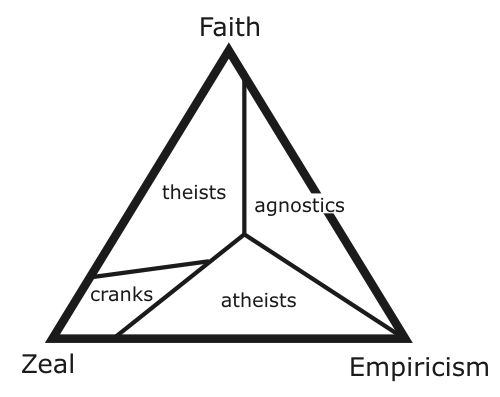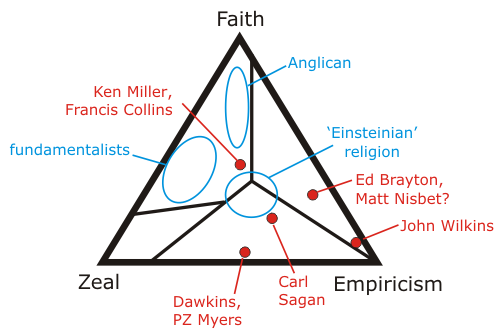I don’t post much on the whole religion thing, but I thought (rather unwisely, perhaps – but I don’t see why Sheril should have all the fun) that the latest meany atheist appeaser agnostic blow-out (see here, here, here, here and, of course, here) was an opportunity to wheel out this analysis (slightly modified for relevance) from ye olde blog, which was inspired by the one before the one before the last one…
I’ve been puzzling over why what is a legitimate dispute between members of the pro-science camp, over emphasis and tone in the struggle against the forces of ignorance, always seems to break down into what could charitably be referred to as ‘arguing past each other’.
A common framing of different theological positions is to represent the continuum from theism through agnosticism to atheism as a change in the relative importance of empiricism and faith in a particular person’s worldview. An atheist places a high value on tangible evidence; a theist is more concerned with the greater truths that they feel exist outside of the world that we can subject to experimental verification (please note that this discussion is not addressing the existence (or not) of such truths…)

I can see some fairly obvious flaws with this representation. Committed empiricists see all the theists, fundamentalist and moderate, lumped together at the far end of the spectrum, which can make them suspicious of someone like Ken Miller or Francis Collins, who are both clearly men of deep religious conviction even though they just as clearly value science. Furthermore, at the empirical end of the spectrum you find people who have little time for faith themselves but will tolerate it in others (provided that religious views are not being foisted too egreriously on the unwilling) jostling for space for people who argue that all faith is silly and even dangerous. The fact that a single axis does not usefully capture the range of viewpoints and how they relate to each other seems to make it all too easy to misunderstand other peoples’ positions.
Because of this, I think at least one more factor needs to be considered, which for want of a better word I’m referring to as ‘zeal’ (I also considered ‘passion’, which might be a less inflammatory choice). This is a measure of commitment to a particular worldview: how much do you care about it being true? Does it bother you that others don’t share it? Adding a third factor to consider allows us to try mapping the different theological outlooks onto a ternary diagram, with Empiricism, Faith and Zeal as the vertices. The advantage of this representation is that it (hopefully) emphasises that I’m not talking about absolute quantities here, but a relative measure of which attributes most control someone’s positioning in the theological menagerie: someone who plots near the faith vertex is not necessarily antiscientific per se, it is just that faith is far more important to them than empiricism.

In this representation, the Faith/Empiricism side of the triangle is dominated by agnosticism, because they generally don’t particularly care one way or the other about such matters (or at least aren’t to bothered by others disagreeing with them). The slope of the boundary between the theist and agnostic sectors reflects the fact that people who are more passionate about their religion can maintain their faith even when they have an appreciable regard for science and empirical reason, whereas less passionate theists are more likely to drift into agnosticism. Likewise, if you tend toward empiricism, the more you care about the existence or non-existence of God(s), the more likely you are to drift over into the realm of the actively disbelieving atheist. I’ve reserved the high end of the zeal realm for cranks and conspiracy theorists, scary people whose passion is tempered by neither faith nor empiricism.
In the next figure, I’ve tried to plot the approximate positions of significant religious denominations and some of the major players in these periodic spats (as far as I can work it out from their contributions to this debate – apologies to anyone who feels misrepresented).

Does this help us at all? In my mind, it provides a new perspective on some recurring problems. For example, the suspicion ‘moderate’ agnostics seem to have of some of their atheist brethren can be understood as stemming from their dislike of too much zeal for any particular worldview; they feel it is divisive and polarizing. Both fundamentalist theists and the more vocal atheists lie in the same direction in this regard, even though the focus of their zeal is entirely different. This confusion between faith and passion may also be partly behind the theists’ “atheism is a religious belief too” argument.
Likewise, the snide remarks which sometimes get directed towards ‘timid’ agnostics by atheists also reflects a misunderstanding – if you don’t personally find the existence (or not) of God particularly important, you are probably happy to stick to the more technically correct position with regard to non-corporeal entities that exist outside of space and time: “there almost certainly is no God, but we can never be 100% certain”, to adapt Dawkins slightly. The mainstream Anglican Church – which places great value on a thoughtful, less boisterous faith, and is looked on with some contempt by the evangelical wing for just that reason – is more than happy to stick God into that gap, which science may make smaller but can never completely close (listen to the Archbishop of Canterbury talking to John Humphrys, for example). This is as close as you get to the ‘non-overlapping magisteria’ idea in the real world: there is still some overlap, but in practical terms it is very small, and allows people (if they wish) to reconcile their faith with the empirical world. This includes people like Ken Miller (who is of course a Catholic, but the idea is the same). In contrast, for fundamentalists the magisteria overlap almost completely; and, because they regard revelation and scripture much more highly than science, in their minds science loses and is denied.
Another interesting feature of this representation is that it suggests that the more zealous theists, if something causes them to doubt their faith, may be more likely to move directly into the atheist camp without any intermediate stops in agnosticism. I think this is interesting in light of the widespread anger amongst the “deconverted” which surprised Dawkins so much on his tour of the US whilst promoting The God Delusion. Perhaps the more zealous Christians are more likely to feel betrayed or lied to if they lose their faith than the former Anglicans who Dawkins would more commonly encounter in the UK, which makes them a bit more passionate in their atheism. And, somewhat heretically, it might suggest that atheists can have an effective role in the conversation – in supporting and encouraging these refugees.
The other sector I’ve tentatively identified in the middle of the triangle is the realm of the ‘Einsteinian religion’ which Dawkins discusses in The God Delusion – where effectively, ‘God’ is the universe revealed by science, capable of inspiring wonder and awe but not so keen on the smiting or prying into peoples’ personal lives. I’m wondering if this is the true middle ground we should be aiming for – the triple point of the theological system. All we need to do is get the moderates to see that a little bit of passion is not always a bad thing, and perhaps get the hardcore atheists to concede that people are always going to believe silly things, but some silly things are more harmful than others, and then we can all be one big happy creationist-bashing family again. Until next time, anyway…



Comments (24)